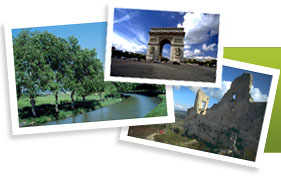Calais Town Hall
Due to the success of the lace-making industry, the population in the village of Saint-Pierre increased greatly and in 1885 it merged with Calais. Work began on the new Town Hall in 1911 although it was not completed until 1925 because of World War I. The Town Hall was built in a Flemish Renaissance style and the spire of the belfry reaches 75m high from where electric bells ring out the hours.
The Citadel
Built on the site of a medieval castle that was built in 1229 by order of Philippe Le Hurperel, Lord of Boulogne, and partially financed by the inhabitants of Calais to provide protection from their enemies. The Lords of Boulogne and Artois first lived there and later it became the residence of the English Kings, including Edward III, until 1558. The French King then decided to turn it into a great fortress by building a citadel, designed by Vauban. Nowadays, the Mediaeval ramparts and the "Boulogne door" can still be seen.
Calais Lighthouse
Standing 51m high, with 271 steps to the top, the lighthouse affords magnificent views over Calais and its surroundings.
Nieulay fort
Designed by Vauban, the Nieulay Fort was built in 1677. It was used as a tollgate for visitors to the city but also the locks of the fort were designed to flood the land around the walled city of Calais in the event of attack and thus prevent the enemy from advancing. Nowadays, the ruins of the fort form part of a pleasant park.
Church of Notre-Dame
The church was built between the 13th and 15th centuries by Flemish Masons but using English architects’ plans, thus creating a very original building in a mixture of Flemish and English styles. In 1691 a water cistern was built on the north side of the nave to collect rainwater for drinking in case of a siege. The church was used for the wedding of General Charles De Gaulle and his wife Yvonne, who came from Calais, in 1921. The church suffered damage during World War II and renovation is still ongoing.
The Risban Fort
The Risban Fort was built during the Hundred Year Wars, in 1328 and in 1622, under Louis XIII, became the starting point for the construction of a sea wall running along the coast to Sangatte. In 1850 the Fort was the main defence for the harbour, and during World War II many residents of Calais used it as a shelter during the bombardments of the town.


